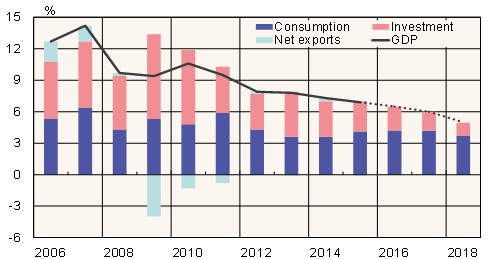BOFIT Weekly Review 39/2016
BOFIT forecast for China sees lower economic growth, rising risks
We have just released our latest Forecast for China. With GDP growth receiving a boost from government stimulus policies this year, we now expect 2016 GDP to grow at 6.5 % p.a. (up from 6 % in our March forecast). Otherwise, the outlook for growth remains unchanged from our previous forecasts. The natural slowing of economic growth is expected to continue in coming years, reaching 6 % in 2017 and falling to 5 % in 2018. Several structural factors underlie the slowdown in growth. The sheer size of China’s economy makes it increasingly difficult to sustain high growth. Demographic trends are also unfavourable and productivity gains have become harder to achieve.
Progress in the shift to a consumption-driven growth will continue. Rapid growth in disposable incomes will sustain strong growth in domestic consumer demand, and growth in fixed investment will slow. However, this year’s trend in investment has been disconcerting. Investment has been largely state-led, while on-year growth of real investment of private firms has been tepid. The contribution of net exports to economic growth in coming years should remain tiny.
Concerns have also increased over the state of the financial sector. Debt-to-GDP ratio is judged to be around 260 %, and indebtedness continues to rise swiftly. Countries that have experienced similar increases in their debt-to-GDP ratios have typically experienced banking crises and rapid economic slowdowns. In China, private firms in particular have piled on debt, even as lower growth and structural shift of the economy has impaired corporate earnings. The weakened state of businesses spills over to the banking sector. Non-performing loans are up and bank buffers have shrunk. The situation for banks will get harder in coming years.
China’s economic development depends on political choices. At the moment, policies of opening up the economy on one hand, and tighter internal controls on the other (e.g. increased censorship and more restrictions) are on a collision course. Moreover, it seems that there is wide disagreements over the direction economic policy among party leaders, which increases the uncertainty.
Chinese GDP and contributions to growth (actual and forecast)

Sources: China National Bureau of Statistics, CEIC and BOFIT.